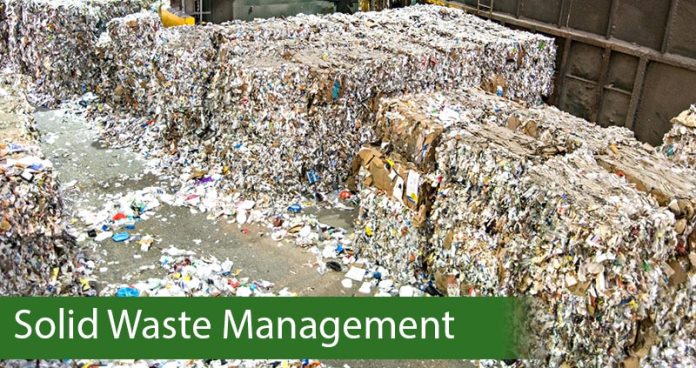Human activities create waste, and it is the way these wastes are handled, stored, collected, and disposed of, which can pose a risk to the environment and public health. In urban areas, especially in the rapidly urbanizing cities of the developing world, the problems and issues of solid waste management (SWM) are of immediate importance.

What is a solid waste management and its definition?
Solid waste here refers to all non-liquid wastes. In general, excrement is not included, although sometimes diapers and young children’s faces can be mixed with solid waste. Solid wastes can create significant health problems and a very unpleasant living environment if they are not dealt with safely and appropriately. If not properly disposed of, the insect may provide a breeding ground for insect-vectors, insects, snakes, and vermin that increase the likelihood of disease transmission. It can also pollute water sources and the environment.
Types of Solid Waste
It can be classified into some different types depending on their source:
- Municipal Solid Waste (MSW): Contains household waste, construction and demolition debris (CnD), sanitary residues and street wastes mainly from residential and commercial complexes. According to the MoEF, this includes commercial and residential wastes originating in municipal or notified areas excluding industrial hazardous wastes in solid or semi-solid but treated bio-medical wastes;
- Industrial Solid Waste (ISW): In most cases, it is known as hazardous waste as it may contain toxins, is corrosive, is highly flammable, or reacts when exposed to certain things e.g. Gases.
- Biomedical waste or hospital waste: It is usually infectious waste that may contain wastes such as sharp, dirty waste, disposables, physical wastes, cultures, abandoned medicines, chemical wastes, etc., usually of disposable syringes, swabs, bandages in the form of. Body fluids, human excreta, etc. These can be a serious threat to human health if not managed in a scientific and discriminatory manner.
Also read: What is Global Warming, Causes and Effects
Treatment methods for solid waste
- Biological treatment methods: This involves using microbes to decompose biodegradable components of waste. 2 types of processes: Aerobic: This requires the presence of oxygen and includes windrow composting, aerated static pile composting and in-vessel composting, vermi-culture, etc. Anaerobic digestion: takes place in the absence of oxygen.
- Thermal treatment: Incubation is the combustion of waste in the presence of oxygen so that the waste is converted into carbon dioxide, water vapor and ash. In addition, waste is labeled in the energy (WtE) method, a means of recovering energy from waste. Its benefits include reduction in waste volume, reduction in transportation costs and reduction in greenhouse gas emissions. However, when garbage is burned, pollutants, such as mercury, lead, dioxin, can be released into the atmosphere and can cause health issues.
- Landfill and open dumping: Sanitary landfill: It is the controlled disposal of waste on the ground in such a way that the contact between the waste and the environment is significantly reduced and the waste is concentrated in a well-defined area. Dumps are open areas where waste is exposed to natural elements, stray animals and birds. Due to the absence of any kind of monitoring and no leakage collection system, it leads to contamination of both land and water resources.
- Pyrolysis and gasification: In this method, thermal processing is accompanied by the complete absence of oxygen or a low amount of air.
Also read: Why Conservation of Biodiversity is important?
Components of solid waste management
- Generation
The production of solid waste is the stage at which materials become legitimacy for the owner and since they have no use for them and are no longer needed, they desire to get rid of them. Items that may have validity for one person do not necessarily have validity for another. For example, waste materials such as cans and cans may be highly sought after by young children.
- Transportation
This is the stage when solid waste is transported to the final disposal site (see 7.6 for more details). There are various modes of transport which may be adopted and the chosen method depends upon local availability and the volume of waste to be transported.
- Collection
A collection simply refers to how waste is collected for transportation to the final disposal site. Any collection system should be carefully planned to ensure that storage facilities do not become overloaded. Collection intervals and volumes of collected waste must be estimated carefully.
- Storage
Storage is a system for keeping materials after they have been discarded and prior to collection and final disposal. In emergency situations, especially in the early stages, it is likely that the affected population will discard domestic waste in poorly defined heaps close to dwelling areas. If this is the case, improved disposal or storage facilities should be provided fairly quickly and these should be located where people are able to use them easily. Where on-site disposal systems are implemented, such as where people discard items directly into family pits, storage may not be necessary.
- Disposal
The final stage of solid waste management is a safe disposal where associated risks are minimised.
Source: www.ec.europa.eu
Garbage Management Problem in India
The problem of garbage management in India has reached such alarming proportions that in August 2018, the Supreme Court of India directed to set-up an expert committee to deal with the issues of solid waste management. The committee must complete each working day for the first two weeks to find a solution. But will this expert committee find some magic solution, which we do not know about?
